Divyaroop Bhatnagar's Blog
February 21, 2024
Cambodia - A Glorious Indic Heritage
Day 1We flew in by Viet Jet the Vietnamese budget airline from Hanoi to the spanking new airport at Siam Reap. It's about an hours drive from the town and the temple complex so that the monuments can be protected from pollution and noise. The drive in the evening passed through forest land and little villages that looked similar to Indian hamlets. Cambodia has a per capita GDP a little lower than India with a population density that is far less. In the daytime, the countryside around Siam Rep looked a bit like Southern Tamil Nadu. Arid with rain fed paddy cultivation (we went in February which is the dry season), palm trees with mango and cashew plantations as well. The soil looks like red laterite again similar to South India.
We were very fortunate to have the services of an excellent English speaking guide during our whole stay in the Siam Reap area. This is invaluable and anybody going to visit the place should get a good guide.
Day 2There is a visitor ticket that you can buy for one day or more that allows for entry to the whole temple area. This includes your photo and is non transferable. The process was quite quick and you could use an international credit card at a very well designed and laid out ticket office.
After buying the three day tickets, the day began with visits to several temples in the Siam Reap area. During the Angkor period (lasting from 802 CE when the Khmer Hindu king, Jayavarman II declared himself a God King up to the late 14th Century), virtually all the kings built temples, so there are plenty to go around! Most of them were Shiva temples built of brick and sometimes stone.

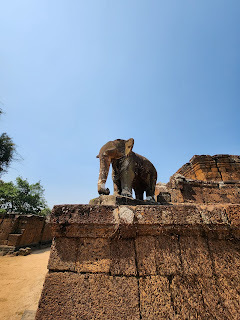
Sometime later, Buddhism began to gain ground and Jayavarman VII (1181 - 1220 CE) became a Buddhist, so we saw some Buddhist temples also. The depiction of a large Buddha bust as part of the temple Gopuram was a unique feature of these temples.
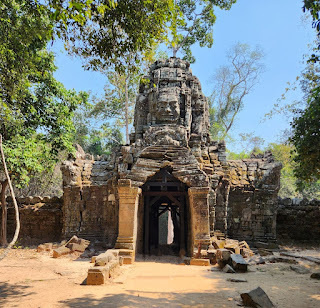
What was also interesting was the continued presence of Hindu gods even in Buddhist temples. Another feature that we found repeatedly in many places was a depiction of the Samudra Manthan with the devas and the asuras with the Naga forming a railing across bridges even in modern construction.

Later in the evening, we went to the Phnom Bakheng Temple (late 9th Century) which is located on top of a hill to see the sunset. Phnom means hill in Khmer as we discovered. The scenery was magnificent but so were the Apsara carvings on the wall of the temple.
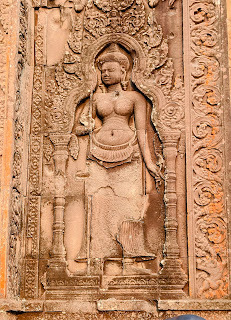

Back to the hotel for dinner and an early night as we were going to see Angkor Wat at dawn.
Day 3We woke up early to see Angkor Wat at dawn. Cars have to be parked some distance away and we had to walk a considerable distance to cross the moat and enter the temple. Inside there are two reflecting ponds and the view of the temple reflected in the water as the sun rises is magnificent. There was a huge crowd of tourists but it was a relatively peaceful experience. As the sun was about to rise the temples were bathed in a glorious red colour making the early start worthwhile.
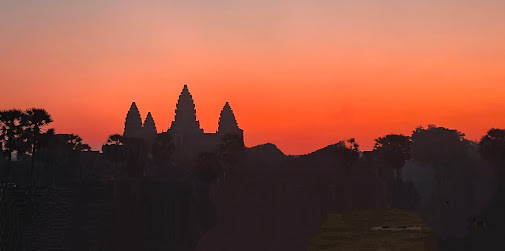
The 'Param Vishnu Lok' (the original name of Angkor Wat) created by the Khmer King Suryavarman II, in the 12th Century lives up to its name and how! It is simply huge. The site covers an area of over 400 acres with the outer wall measuring 3.6 Km. The moat is really like an enormous lake more than 5 Km long. Later, we went up in a helium balloon that gave us a better idea of the scale and expanse. I understand that this is the largest religious site in the world.

There are enormous galleries each carved with scenes from the Mahabharat and Ramayan and the Amrit Manthan. I've never seen anything on this scale before.
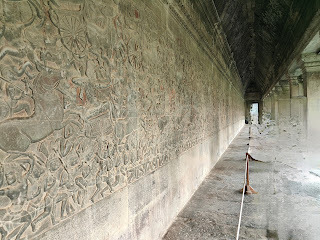
In later centuries, as Buddhism took over in Cambodia, the main Vishnu statue in the sanctum sanctorum was displaced by an equally beautiful Buddha statue.
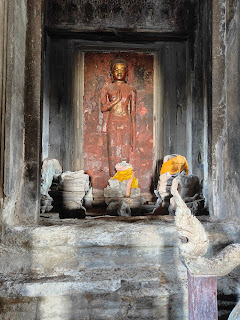
Vishnu is now relegated to a side gallery but he is still revered. Along with the change of religion, the name of the temple was changed to the more mundane Angkor Wat simply meaning the temple of the city.
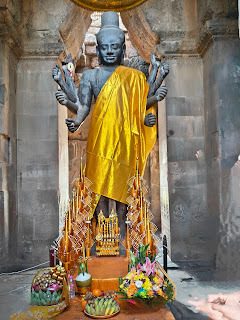
In the afternoon, we visited the richly decorated Bayon Buddhist temple.


This was followed by a visit to the Ta Prohm (Ancestor Brahma) temple. This is best known for featuring in the Lara Croft epic, The Tomb Raiders. It's also known as the tree temple as it has huge silk cotton and strangler fig trees trees literally growing out of the temple walls. An amazing reclamation of the buildings by nature!

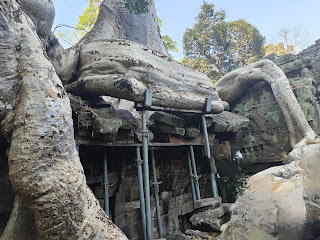
However, the key interesting point that I found was the excellent restoration work being done by the Indian Govt under the auspices of the ASI. This is a very long term, painstaking project and the work done so far in restoring a whole area where the roof had fallen in is really commendable and one of the best examples of restoration being done in the Angkor Wat area. So also a gopuram on the boundary wall.


The Ta Prohm temple was built over a vast area in the late 12th century and early 13th century by the Khmer King Jayavarman VII. It was built as a Buddhist temple as by that time the Khmer king had adopted Buddhism as his religion.
Day 4And the best was surely reserved for the last! After the grandeur of Angkor Wat and the wilderness of Ta Prohm it was difficult to imagine that we would see something so exquisite. We started off with a visit to the 1000 lingas. Carved out of the rocky bed of a small flowing river the lingas are so numerous that you can't count them. They end with a very large linga and a carving of Vishnu resting on the Shesh Nag all in the river bed with water flowing over them. It's an extraordinary depiction and an inclusive one as well.

We also visited a Buddhist temple on a hill that had statutes of Shiva and Ganesh as well. A Buddhist priest was pouring water over a Shiv Linga and the people were taking the water and pouring it on their heads before worshiping at the Buddhist temple.
Finally, after lunch we went to see the Bantey Srei Temple. Consecrated in 967 CE, the credit for the construction does not go to a king but to some of his courtiers. Built out of red sandstone, the carving is exquisite. It's a Shiva temple and one of the pediments has an amazing depiction of Shiva riding Nandi with Uma at his side. I've never seen anything like this. This temple is built on a much smaller scale than the later ones in the area but it is really beautiful.


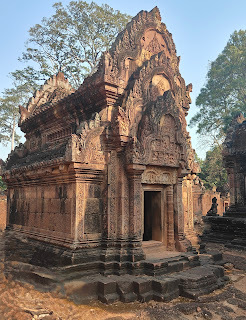
Day 5We bade goodbye to Siam Reap and drove to Phnom Penh. This is a 5 hour drive through fields and farmland. Nearer Phnom Penh, we saw the mighty Mekong river on whose banks the capital city is situated. Phnom Penh first became the capital of Cambodia in the post Angkor period in 1434 but did not remain so for long. Later, during the French colonial regime, it regained its status.
Our first visit was to the Royal Palace. The principal building houses the ceremonial jewels and has a prized relic of Buddha as well as an Emerald statue of The Enlightened One.

There is also an extensive frieze of the Ramayan painted on a long wall running on three sides. This painting is showing signs of deterioration. Perhaps the Indian Govt could offer to help with the restoration.

Day 6We started the day with a visit to Wat Phnom Daun Penh a Buddhist temple from which the city derives its name. The theme of guardian lions (an animal never found in Indo China), Nagas, and the roof supported by Apsaras and Garuda figures testifies to the inclusive nature of Cambodian religious beliefs.
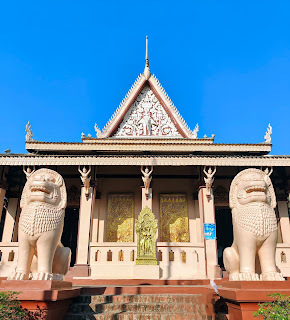
The highlight of the day was a visit to the National Museum of Cambodia. I have rarely seen a better collection of Indic art and culture even in India. It's humbling and thrilling to to see how Indian culture, religions, scripts and thinking had crossed the oceans thousands of km away in such detail and profusion over two thousand years ago. Clearly, the contacts and interaction were extensive and spread over a long time. There are many stories and legends about this. One relates to an Indian merchant from Kalinga who married a Khmer princess, Soma and became King Kaundinya I of Funan, that comprises of most of modern Cambodia centered around the Mekong delta in the first century CE. Conversely, one of the Pallava kings in Kancheepuram was a Prince from Cambodia/Vietnam, Nandivarman II in 731 CE. In addition, there were widespread imports of priests, accountants, tax collectors and the whole apparatus of state governance by Cambodia from India over a period of more than 1000 years resulting in a thoroughly Indianised society. Some of this persists even today.
The exhibits at the National Museum were beautiful. Here are some examples.
Buddha with the Mudras fully intact.

A 'Mukholinga'. This is a very unusual depiction of a Shivling. The square base denotes Brahma, the creator. The octagonal centre represents Vishnu, the preserver and the Linga on top is Shiva, the destroyer.

A delightful statue of Shiva playing with his son Skanda (Murugan)
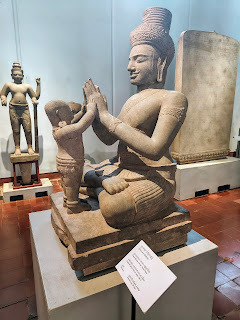
Bali and Sugreev in combat

Ram and Hanuman
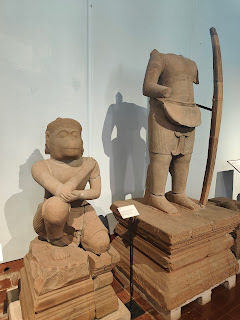
Garuda

A group of Buddha figures
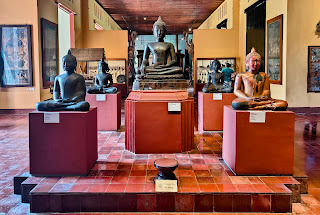
However, the key point that fascinated me was the theme of inclusion, tolerance and synthesis that is visibly evident in Cambodian temples from ancient times to the present day. In token of that spirit, Nandi is still revered in a Buddhist state as in this beautiful depiction outside the National Museum.

In pre Angkorian times both Hindu and Mahayana Buddhism entered Cambodia via contacts with merchants from India. Most of the Angkor kings were Hindus with a few Mahayana Buddhists in between. After the 13th century CE, Theravada Buddhism came into Cambodia. King Jayavarman VII sent his son to Sri Lanka to be ordained as a Buddhist priest. Subsequently, the whole country converted to Theravada precepts in a smooth and non violent fashion.
The evolution of the Cambodian script is also interesting. Earlier examples under Yasovarman I (889–910 CE) are clearly identifiable as being derived from North Indian scripts while the later versions appear to be derived from an old South Indian script, Grantha. The modern Cambodian script has much in common with South Indian scripts.
An example of a North Indian based script used by Yasovarman 1.
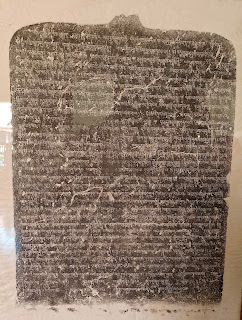
An example of an ancient Cambodian script based probably on Grantha, the precursor to modern South Indian languages. This script later developed into the modern Cambodian script.

We flew out of Phnom Penh airport to Ho Chi Minh City later in the evening, ending a wonderful stay in Cambodia.
PostscriptThe Cambodia, Laos, Vietnam area is collectively known as Indo China and was administered as such under French colonial rule. Going by our experience in Cambodia, it appears that the influence of China was at best a tepid one. India's influence was clearly paramount in ancient times.
I hope you liked this travelogue. You may like to take a look at my published books as well. Just click on the links below to buy the books from Amazon.
The Mussoorie Murders
Journey to the Hills and other Stories
January 27, 2024
Keezhadi - Musings on the origins of Indian Civilisations and Writing Systems
I have a fascination for ancient Indian history and in particular for languages and scripts that have eluded decipherment over the centuries. It's a strictly amateurish interest though. I have no new research to offer. Only a combination of recorded history and speculation. My earlier article on the Saraswati river elicited a lot of interest so here's the next one almost 10 years later!
When I started writing this article, I wasn't sure where it was going. It seems to have meandered along between the origins of homo sapiens to the Iron Age and arrived at my favourite hobby horse - ancient scripts!
Enjoy the read.
The small town of Keezhadi (also written as Keeladi) is situated on the bank of the Vaigai river near Madurai in Southern Tamil Nadu. The ASI (Archeological Survey of India) commenced excavations in 2013, barely 10 years ago. Subsequently, the Tamil Nadu Archaeology Department has taken over with excavations continuing to date. The findings have been interesting and controversial too!
To explore further, we need to rewind into prehistory - to the time when homo sapiens developed in Africa and started migrating outwards.
Though the migration of primitive humans out of Africa started very early, it is generally accepted that the 'recent dispersal' of humans out of Africa around 50,000 - 70,000 years ago led to stable human populations around the world. There seem to have been two streams of population that moved into India. One that entered through North West India and moved across the Indo Gangetic plain towards South East Asia and the second a stream that entered India along the western coast and moved southwards and then back up the east coast. The two streams merged in eastern Indian and moved together thereafter.
Paleolithic (early stone age hunter gatherers dating from 500,000 - 10,000 BCE) sites have been found in various parts of India including Tamil Nadu (Attirampakkam) pointing to widespread development of stone tools and weapons. Some of these societies progressed into a Neolithic culture with the development of agriculture, pottery and finer stone tools. Neolithic cultures have been observed in several sites in Tamil Nadu as well. The dates here range from 2800 - 1500 BCE
The next significant human development has been the ability to use metal, starting with copper and bronze. India entered the Bronze Age with the Harappan Culture in around 3000 BCE. Interestingly, there does not appear to be any evidence of Neolithic cultures transiting to the Bronze Age anywhere else in India. Rather, in places like Tamil Nadu, Iron Age cultures have appeared without evidence of an intervening Bronze Age at all. One such example is Keezhadi.
However, before we come to that, one significant point that does strike me is that the Paleolithic and subsequent Neolithic cultures that came up in India in various places came up independently. There does not appear to be a link between them and there is no one 'mother culture' or primal site that came up first and the others followed. Secondly, Paleolithic cultures came up in all parts of India implying that both streams of migration out of Africa (Coastal and Indo Gangetic) were productive insofar as future development of mankind is concerned. These inferences are very important for the subsequent analysis in this article.
The traditional Aryan Invasion Theory (AIT) postulates that the invading Aryans defeated the inhabitants of the Harappan civilisation who were the original Dravidians and forced them to disperse southwards. This happened suddenly in around 1200 BCE. Thus, the Bronze Age Harappans dispersed carrying with them the knowledge of smelting of Bronze that they had been using over the years. One would have expected them to use that knowledge in their new homelands and set up Bronze Age settlements elsewhere but surprisingly that did not happen. The Harappan script also did not make an appearance in any of the places where the people had allegedly moved to. The purpose of the foregoing is not to suggest a solution to the mystery of the Harappan civilisation but rather to postulate that there does not appear to have been a significant (sudden or on a big scale in a short period) level of contact between the Harappan civilisation and other burgeoning civilisations in India. The alternate view that there was no dramatic AIT and that due to a change in weather patterns and the drying of the rivers like the Saraswati, the inhabitants of the Harappan Civilisation gradually dispersed into the subcontinent, primarily into the fertile Indo Gangetic plain and their language and technology largely withered away.
Coming back to Keezhadi
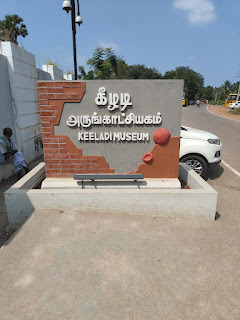
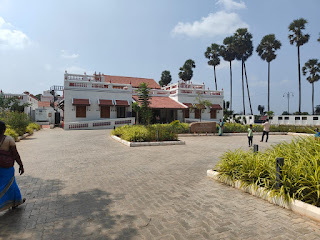
There is an excellent museum near the archaeological site that explains the findings in a simple fashion. It is clear that Keezhadi was an Iron Age settlement from the third Sangam period in Tamil Nadu. The dates have been well established by radiocarbon dating as 580 BCE to 300 CE. There are many iron artifacts such as sickles, nails and rods and remnants of furnaces and ore that clearly establish that it was indeed an Iron Age site. Interestingly, gold bars and jewelry have also been found so it is clear that the inhabitants had an understanding of other metals as well. Perhaps, the use of Bronze may have been for a short period or not at all. I was unable to find any references to the use of Bronze at Keezhadi though. There is also ample evidence of seafaring trade with the middle East and even Europe as there are many Roman coins that have been unearthed.
The question is whether Keezhadi developed independently as an Iron Age site or was there movement of Harappan Civilisation people southwards consequent to the Aryan Invasion that led to its establishment?
Frankly, the idea that the Harappans populated Keezhadi strains credibility. Amongst ample evidence of Paleolithic and Neolithic sites in the vicinity and the direct development of iron working that the Harappan Civilization never had it appears highly unlikely that the Harappans trekked thousands of km southwards and developed iron working skills along the way to set up Keezhadi. It is far more likely that this is an independent development.
The most interesting thing from my perspective was the use of the Tamil Brahmi script at Keezhadi. The script is referred to as Tamili locally indicative perhaps of a desire to appropriate an indigenous origin to the script. Tamil Brahmi is clearly recognizable as Ashokan Brahmi with a few alterations/additions to accommodate sounds not commonly used in North India.
Fragments of potsherds with Tamil Brahmi writing have been found at Keezhadi that have been dated to 580 BCE via radiocarbon dating.

The date presents a problem. As of now, the earliest examples of Brahmi inscriptions are from Emperor Ashoka's time 268 - 232 BCE. Tamil Brahmi is said to have evolved via interaction with the Mauryan kingdom, not the other way round. So did the script emerge first in Tamil Nadu and then travel Northwards? There is a controversy around this point. Many archeologists question the methodology that was used for radiocarbon dating at Keezhadi pointing to 580 BCE as the earliest date for when the settlement came into being, not when the potsherds were inscribed with Tamil Brahmi letters A similar controversy exists around Sri Lankan Brahmi with findings from Anuradhapura allegedly predating Ashokan Brahmi.
The dating controversy notwithstanding, it is clear that Brahmi was in universal use in India around 250 BCE with several languages using a common script. There are 3 alternative theories pertaining to Brahmi's origins as follows:Brahmi emerged as an adaptation of a Semitic script. Trade contacts with the Phoenicians existed for a long time in both North and South India. The script candidates from which Brahmi is said to have been derived include Aramaic and Kharosthi. Brahmi evolved out of the Harappan Script. Ashoka created Brahmi and enforced it as a script for universal useThe Harappan Script had died out by 1200 BCE while Brahmi emerged around 250 BCE. Hence there is a gap of 1000 years in between. Some scholars point to an evolution from Harappan to Brahmi in inscriptions at Bet Dwarka and Daimabad but these claims are unsubstantiated as indeed the decipherment of the Harrapan script itself is still elusive. Scholars also remain indecisive about the derivation of Brahmi from a Semitic script. The differences appear to be more than the similarities.
That essentially leaves us with the enigmatic and powerful Mauryan emperor Ashoka. Did he decree the creation of a Script (Dhamma Lipi) for his edicts that was simple and easy to read? It is not beyond the realms of possibility as there was no script available in India at that time. Perhaps he looked at the plus points from Semitic scripts and modified them to create Brahmi. This amazing script led to the evolution to writing systems throughout Asia and it is estimated that today as many as 198 scripts are derived from it. After the collapse of the Mauryan empire, local scripts continued to evolve but as late as the Gupta period, almost 700 years later an educated person could still read Ashokan Brahmi.
So ending on an optimistic and wishful note. Perhaps India needs to consider bringing back a universal script that could be used by all languages (and what better candidate than Brahmi?). This would facilitate the ability to read all Indian languages even if you can not understand the words. A similar situation prevails in Europe and even Turkey adopted the Roman script under Ataturk.
Perhaps the long arm of Emperor Ashoka can still reach out and bless us with the benediction of a universal, nation wide script.
January 3, 2024
Impermanence
Indians have been conditioned to seek stability and 'permanence' in everything we do. Family relationships, especially stable marriages are the bedrock of our society. Jobs and careers follow the same pattern. The sturdy middle class always sought government jobs as ones that were not run by pernicious capitalists and offered a stable, albeit somewhat stultifying future for young aspirants. The pinnacle, of course, was the IAS or one of the central services.
This entire mindset has gone through a seismic change in the recent past. Some examples would serve to illustrate the point:
Marriages are not as stable as they used to be. It's another matter that marriages in the past may not have been stable either but there was a strong social stigma attached to divorce that prevented them from falling apart altogether. There is no such thing now. Divorce rates amongst the middle class (the labour class anyway has had a fairly relaxed approach in this context) and above have skyrocketed and a single woman divorcee does not attract the same societal opprobrium as earlier. Second and third marriages are fairly common and the 'yours, mine and ours' concept for children is becoming far more visible.The most striking aspect of impermanence is clearly the attitude towards jobs. Not so long ago a young man or occasionally woman, was lucky enough to land a respectable government job soon after they graduated. This would form the basis of an honourable livelihood for the rest of his professional life. It would also define his social status, friends circle and the kind of people whom his children got married to. The first transition was to a private sector job instead of a government one. This was bad enough but it was compounded by increasing opportunities in a rapidly growing economy. The temptations of new opportunities and more money has led to a roller coaster of new jobs every few years or even months. A man no longer treasures his first scooter or car that he acquired after a long wait and much penny pinching. Ownership is increasingly passé. Ubiquitous Ubers and Olas have made car ownership unnecessary and even burdensome in our crowded cities. Even if you do decide to own a car, leasing is becoming the preferred option rather than buying. This is aided by rapidly evolving technology that constantly tempts you to move up to the next best thing. Mobile phones are a classic example of this. If you do change every two years to the latest shiny Apple and Samsung, do you stop to think that the cost of the hardware is likely much more than the service that we constantly complain about. It may be food for thought that if we were willing to pay a little more for better service and kept the same phone for 4 years we would be probably be far happier with the outcome.The fact that rental yields are abysmally low may just be finally sinking in. At a 2% return on the replacement value, it makes far better sense to rent a house rather than buying one. In the previous generation, people struggled to buy their first homes with expensive bank loans and sacrificed holidays and what little luxuries they could afford for the stability that home ownership offered. The 'here and now' is much more important today and young people would rather spend on a holiday abroad than be tied up to a low yield asset.This list could go on. As of now all this sounds depressingly familiar as it follows the track that most western countries have been on for quite some time.So does the concept of 'impermanence' have an Indian idiom? Will Indian society inexorably follow the path that the west has been on?
The idea of impermanence is deeply embedded in Indian philosophy. One of the most striking examples of this is the way that Hindus treat the body after death. There is no burial and after burning the ashes are immersed in the Ganga. There is no attachment to the body. The atma is immortal and depending on what your karma specifies you could have a rebirth or attain moksha. Does this thinking permeate our daily lives?
Interestingly, it does not.
Hindus, and I dare say, Indians in general believe in the impermanence of the body yes, but not the impermanence or rather instability in the process of living.
I feel that adoption of western concepts and ways of life tends to follow a kind of a S curve in India. Adoption starts slowly and then accelerates upto a point but then it flattens out. I may be sticking my neck out here but I would hazard a guess that divorce rates, for example, will not reach western levels in India even in heavily urbanised and westernised parts of India. Adoption of western food items like breakfast cereals have also followed this kind of pattern. Eventually idlis and parathas will prevail over breakfast cereal. There are many MNCs who have learnt the hard way that India will not mirror western market constructs and that one has to learn the Indian way if you are to succeed in this market.
One may argue that the leap from breakfast cereals to a metaphysical concept like impermanence is a tenuous one. Suffice it to say that most Indians are grounded in a reality that has been a long time in the making and one that is not easily shaken. There is something about a 5000 year old, unbroken civilisation in each one of us. World thought leaders? Mais non! But self confident in one's own skin, certainement!
July 31, 2023
East African Safari
Our daughter Priya and her family had planned a family holiday in Kenya and Zanzibar last month. Her in laws, Dilip and Shrimi Sinha joined us, so eventually we were a party of 6 adults and 2 children.
We flew Qatar airways to Nairobi via Qatar. The Delhi Doha sector was a code share flight operated by Indigo along with their trademark junglee sandwiches. The flights were quite unpleasant - in the middle of the night and too short to get much sleep. Fortunately, now Air India has started a direct Delhi Nairobi flight that will make things much better. Doha airport is quite stunning - beautifully laid out with great shopping and dining options.

Day 1
We landed at Nairobi airport in the morning on time. The airport is apparently temporary and it shows! It's quite shabby and looks like a real dump. I hope they get the new airport up and running soon. We were met by very courteous drivers who drove us to the Eka hotel where we were staying. We had breakfast and as some of the rooms were ready we freshened up as well.
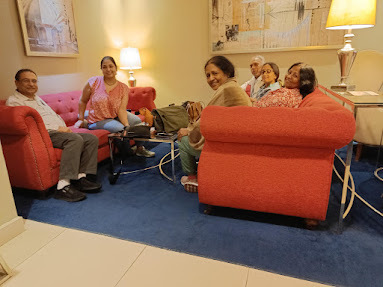
Then we were off - to the Giraffe Manor where they have a high platform for feeding the Giraffes. They give you some pellets in a coconut shell - all very natural and eco friendly. The whole experience was and very exciting for all of us. Later we heard a talk about Giraffes and learnt how to differentiate between the various species.

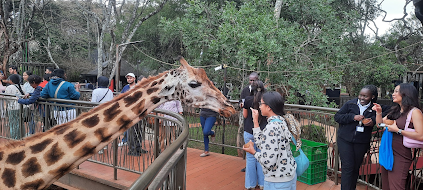

We then went to a workshop where women were making beads made of volcanic material. They put up a nice 'hakuna matata' dance for us.


After that we went to a museum that had a snake park attached. The children made a bee line to see the black mambas and pythons that they draped around their necks.

The guide at the museum was outstanding. We were fascinated by glimpses of the first man on earth and how all humans developed in Africa and then moved out. We overshot the time that the museum was to close but the lady was very kind and we reluctantly left to return to the hotel.

Nairobi is a beautiful city. There is a very large slum but the more affluent areas are terrific with colonial bungalows, greenery and wide roads. Being at an elevation of around 5000 ft the weather feels like Bangalore. Cool all the year round. We had dinner at the hotel and went to sleep early exhausted after the sleepless night on the flights.
Day 2
At 8:30 next morning we were picked up for the drive to Lake Elementeita.

This is one one of the five lakes around the rift valley in Kenya - the lakes are all salt water and a haven for flamingos. The drive was very beautiful along the ridge - the scenery is reminiscent of South Indian hill stations like Ooty and Kodaikanal and the misty, cool weather adds to the feeling. The continent of Africa is being cleft into two at the rift valley that runs from north to south. Maybe in a few millennia, some new land masses may make their appearance.

The Serena Hotel at Lake Elementeita was great. Well laid out and protected by an electric fence to keep the large animals out.




The view of the lake was spectacular - full of pink flamingos covering most of the water area. They feed on algae and apparently the pink colour is dependent on the quality of their food.


There was a viewing point for the lake that had antelopes just outside. An idyllic spot! Food was great at the hotel. The only problem was that the orders were taken individually, plated and served so it did take a while. Started our journey of exploring local beers with 'Tusker' a light crisp lager with a faintly bitter aftertaste but perfectly acceptable. Next day we went for our first safari to the Lake Nakuru national park, where we saw the white rhino.

We were lucky to see a whole bunch along with numerous zebras, baboons, antelopes and birds.



The park is right next to a city and we were pleasantly surprised to see such plentiful wildlife so close to an urban area.
Back to the hotel and time for some more beer exploration. This time we tried Balozi that did not turn out quite so nice. An early night so we could leave for the Masai Mara next morning.
Day 3
The drive to the Masai Mara was quite beautiful as it followed the rift valley for some of the time. We then turned off into an unpaved road and while the Range Rovers made good time it was a bumpy ride and we were quite worn out by the time we reached our camp. We crossed the famous Mara river on the way.

The camp was named Kichwa Tembo near what is called the Mara Triangle. This is a spectacular property. The rooms were to top of stilts around 10 - 12 feet high. These were tents that could be unzipped to let in light and air. We were advised to keep the netting closed at all times as the monkeys were quite aggressive.
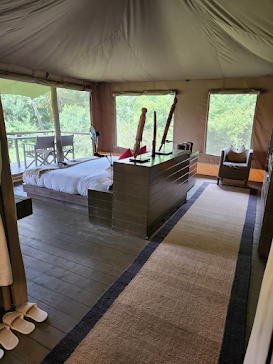
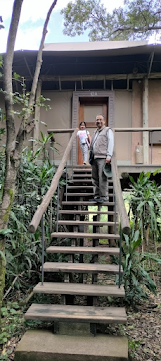
The main areas of the resort opened out towards the open grassland of the Mara and we could often see elephants and antelope vending their way across. There was an electric fence in a deep ditch to keep the larger animals out.


But the resort had it's resident wart hogs (pumbas) that wandered around at will. The food at the resort was excellent with alcohol also included in the price. There was a great chef in charge at the live counter. He was a real artist and kept up an interesting conversation while he prepared eggs for breakfast or grills for lunch and dinner. Amazing variety and quality of fresh produce in the middle of nowhere!
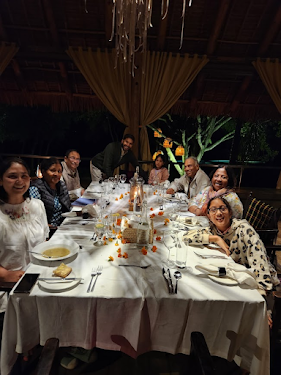
Day 4 and 5
These were spent in game drives around the Mara triangle. We went up to the Tanzania border with the endless Serengeti plain stretching far towards the South.

We crossed and re-crossed the Mara river but the actual river crossing of the wildebeest herds was still to come.

The river is rather narrow and we saw a herd of hippos wallowing on one side with a huge crocodile sunning himself on our side.


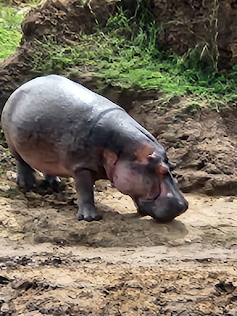
Lions in plenty. A full pride as well as a fellowship of males gorging on a buffalo that they had killed. The next day the lions were gone but the hyenas and vultures were picking the bones clean.

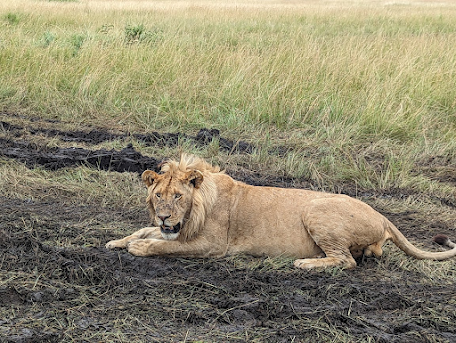


We saw many cheetahs including three that failed to hunt down a zebra who stood his ground and shooed them off. An ostrich exploring something on the ground.
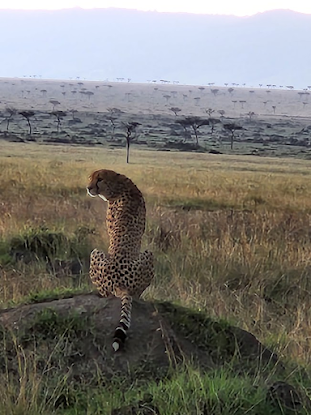

Then a leopard loping around in the distance oblivious of the prey all around. Herds of Zebras and Antelopes were everywhere. Buffalos demonstrating the democratic manner in which they move - almost like an election to decide which direction they will take next. Elephants in plenty and some really beautiful pictures as a result.


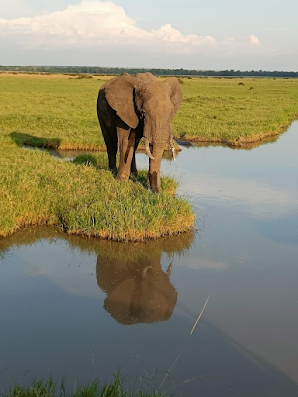
We saw the big five on this trip - Lions, Leopards, Elephants, Buffalo and Rhino.




The Mara is stunningly beautiful especially at dawn and sunset with the endless grass stretching for miles and the sky awash with colour. There are few trees but the predators still manage to slink up to the their prey. The predators hunt to feed themselves, not for enjoyment. Africa is like a drug. Once you've tasted it you WILL come back. This time with a better camera!
India woke up to the depredations of hunters and the spread of population a little late but I think we have a well developed sense of ecological preservation now. Africa has far more animals. Long may their wilderness last.
Day 6
A reluctant good bye to the Masai Mara and drive back to Nairobi. We reached at lunch and checked in to the Tamarind Tree Hotel. This is conveniently located close to the Wilson airport from where we were to take a flight next day to Zanzibar, The evening was spent at a mall looking for Kenya souvenirs and a good dinner - mix of Indian and Chinese food.
Day 7
After a little confusing security and immigration procedures at the small Wilson airport in Nairobi we boarded a turbo prop plane for Zanzibar.
Zanzibar is one of those places you read about in stories from the Arabian nights. And here we are! After a scenic flight from Nairobi flying close to the cloud covered summit of Mt Kilimanjaro we landed at a modern airport. Our resort was on the other side of the island so we drove for an hour and a half to get there. Incredible white sand beach stretching for miles.


Beautiful resort, the Breezes Beach club on the Indian Ocean side. Went for a morning walk when the tide was out and the sky was awash with colours. Total relaxation after a few strenuous days of safari.
Day 8
Today we drove to Mnemba beach at the northern end of Zanzibar. A boat ride on a heaving sea was kinda ok but the sight of the dolphins was exciting!


Hakuna Matata! The best philosophy of life.
Day 9
The last day in Zanzibar was very interesting. We went to Prison Island first.

It now has a tortoise sanctuary with the oldest resident being 196 years old! Munching away on lettuce and green leaves these ancient specimens have droopy eyes and thick leathery shells.

There were quite a few peacocks strutting around as well.

A short boat ride away from the town. Then Freddie Mercury's house where he was born.

Some spice shopping and then a good lunch at the Africa house restaurant overlooking the sea.

Stone Town needed more time for exploration, maybe stay there for a day.
Then a long flight(s) back to Delhi and some much needed sleep.
Very enjoyable family holiday. Many thanks to Priya Bhatnagar Sinha and Abhinav Sinha for planning the whole thing and to Dilip Sinha and Shrimi Sinha for the great company! More African safaris coming up!
Photo Credits: Abhinav Sinha, Priya Sinha, Gayatri Sinha, Nayantara Sinha, Devi Muthu Bhatnagar, Dilip Sinha and Divyaroop Bhatnagar
February 26, 2023
Wandering around the heart of India
Madhya Pradesh holds a special fascination for me. It does not have the crowds of UP and the year that I spent in Indore was a good exposure to the natural beauty and history of the place.
Govind and Sudhi Pradhan were kind enough to invite us for their son Mudit's wedding at Orchha on the 1st and 2nd of Feb so we started planning a trip after the wedding festivities. Our dear friends Kishore and Guddo were happy to accompany us on our wanderings, the new Innova Crysta was bought specially for these urges so we were all set to go!
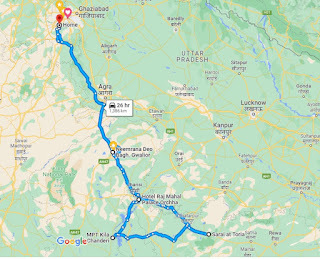
Feb 1 and 2
We left Gurgaon leisurely at 8 am after breakfast though we packed sandwiches, 'just in case'. As it happens Kishore had made some special sandwiches as well so we had enough and more to go around! Learning from our last experience of driving to Gwalior we did not take the Yamuna Expressway but took the old Delhi Agra road instead. If you take the YE, you have to plough through all of Agra to get on the Gwalior road while the old road has a nice bypass. We reached Orchha in 8 hours with very little time spent in stopping on the way. We had booked at the Rajmahal Palace Hotel - most of the hotels were full as there were two destination weddings happening in the town on that day! It was choc a bloc. It seems that people from Kanpur and other UP towns have discovered the charms of Orchha as a wedding destination. If you are planning to go there do book well in advance. The Amar Mahal is probably the best hotel. Rajmahal was OK but the rooms did not have a proper window and the bathroom had an exhaust fan that kept going all the time with a rather irritating sound. Having said that the hotel food and ambience were pretty good. The wedding festivities were brilliant but I will not dwell on that. The fun and games at a big fat Indian wedding are hard to beat!
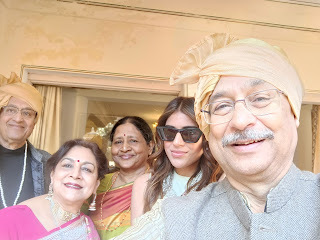
I have covered Orchha, Khajuraho and Gwalior in a previous blog so will not focus too much on these places. If you want to read about that trip, click here MP trip 2021
Feb 3
After attending the wedding at Orchha, we set off to Chanderi for a spot of saree shopping. We were on narrow state and district roads for some time and got caught in a temple festival. The police had blocked the road so we had to take a diversion through some rough roads. The Innova took all this in it's stride and we eventually reached Chanderi in about 3.5 hrs. The town has a history dating back to pre Mughal days when the fortress changed hands several times. We went to a wholesale outlet for sarees who also took us to see the weavers in action. The MP govt has created a new complex for the weavers that is quite modern. Hopefully the handloom industry will survive the onslaught of power looms that are more efficient but the cloth feels different from handloom. As in Varanasi, the weavers are Muslim while the businessmen who organise the sales are Hindus. Interestingly, the silk comes from Korea, Japan or China - Indian silk is apparently not up to the mark. Maybe an area of focus for the agriculture sector in India.

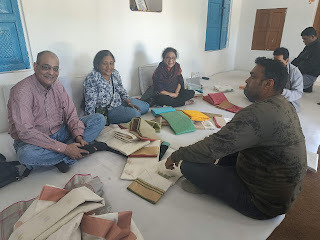

We are staying at the appropriately named Kila Kothi hotel of MP tourism. The kila has the grave of Baiju Bawra who was a legendary singer around the same time as Tansen. With a johar site just next door and a khooni darwaza where prisoners were summarily despatched by throwing them off the cliff, one hopes that we have a restful night!

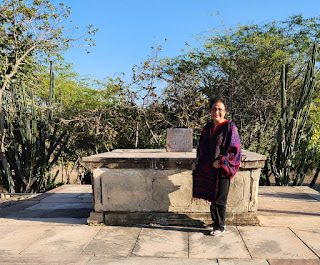
Feb 4
We had a very restful night indeed aided by some excellent red wine and a nice dinner provided by the hotel. We set off after breakfast for Khajuraho.
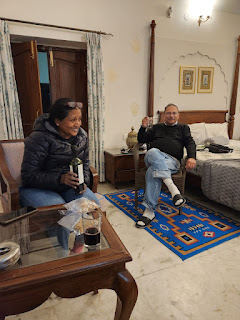
Tourism is witnessing a rebound and the place is much more lively than we saw in Feb 2021 during Covid. The govt has made a new approach to the Western temple complex. It looks good but you have to walk a lot and the electric rickshaws that are supposed to ferry people were not in evidence yet. The ticket booking is still on the net via a very tedious payment process. I cannot figure out why some nameless Babu wants to know your aadhar number as nobody looks at it anyway! Touts happily get you a ticket for a little premium. Ah India, some things will never change.It's a blessing that the remnants of the splendid architecture of the Chandelas will never change either. The sculpture of the Khajuraho temples for me represents the flowering of Indian civilization before the Islamic invasions. Liberal, artistic, spiritual, knowledgeable, high status of women etc etc. The list is long. IMHO if we need a role model for a society that we need to be like, look no further than ancient India! After looking around at the temples we came to a beautiful and rustic lodge near the Panna National park called The Sarai at Toria.
Feb 5
What an amazing day! We got up early to go for a safari in the Panna National park. The hotel (more about that later) had thoughtfully provided a much needed blanket and a hot water bottle to ward off the morning chill.
We set off into the park and the initial couple of hours were uneventful. We had a delicious breakfast in a clearing on the bank of the beautiful Ken river and set off again. We saw plenty of deer and nilgai but after a while we saw a leopard walking along a hilly ridge. A good sighting but at a distance. Then just as we were on our way out we saw 2 jeeps stopped ahead of us. A tigress was calmly walking around just a few feet away! An amazing sighting indeed.

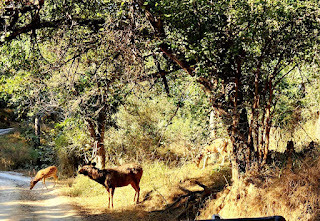
We drove back to The Sarai at Toria really happy with the morning's work. We had a delicious lunch served outdoors near their vegetable garden under a shady tree. Beetroot soup, greek salad, an aubergine dish the like of which I have not tasted before, gnocchi with pesto followed by a campari pana cotta. The food here is outstanding. So are the rooms and service. This hotel is a real gem.
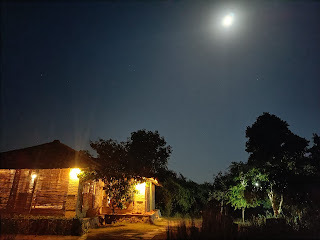
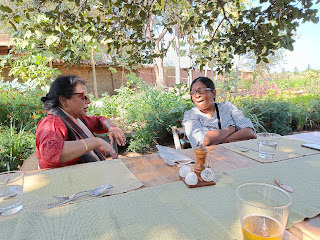
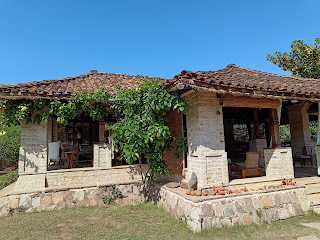
Later we went for a boat ride at sunset on the river Ken. This was a serene experience with many birds to see and to watch the golden sunset. Later the full moon rose against a star spangled sky. This is a magical place.
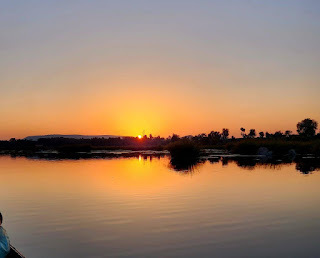
Feb 6
We left Panna and reached Gwalior in 4 hours beating Google's estimate by 45 mins. I think Google has still not figured out that the road in now incredible. Driving on the 4 lane National Highway was a breeze. If I was to pick one area where India has made dramatic and visible progress I would unhesitatingly pick the roads and highways. We are soon going to be at world class levels.Neemrana's Deo Bagh is just as I remembered it. A large lawn with rooms on 2 sides. After a nice lunch we set off to the Fort and went into a Google induced loop with the car having to squeeze thru narrower and narrower lanes. For future reference, one must search for Urvai Gate, not some generic search term. This has happened 3 times on this trip. The algorithm should include best route rather than the fastest/shortest one!Coincidentally, we got the same guide for the fort that we had got two years ago. He's quite knowledgeable and does not talk too much. The fort is as interesting as ever but the sound and light show was not working. Got back to the hotel and met the delightful couple who own the property. It was a fun conversation....
Feb 7
Had breakfast and drove back to Gurgaon. Uneventful drive. We covered around 1500 km in the whole trip and spent Rs 1995 on toll - not cheap but worth every penny.
Here's to many more road trips! The best way to experience the magic of India.
January 25, 2023
Indraprastha to Pataliputra - A Bihar Travelogue
Our Samdhis (Dilip and Shrimi Sinha and Shrimi's father Dr HRP Varma) are from Patna and when they suggested that we join them there in January, we jumped at the opportunity. I hadn't visited Patna for years and anyway the last few trips time had been for work so there had been no time to visit any of the historical and cultural sites. I had a faint recollection of my Chachi's father's house in Danapur when I had visited as a child. So all in all, it was going to be a new experience.
Day1
The flight to Patna was on Indigo. Landed on time at Patna. We had to walk to the terminal building which was a bit of a downer. There does seem to be a new terminal coming up but I heard that expansion in the current site is not going to be very easy. The airport could do with a facelift. However baggage arrived soon enough and we exited. The drive home was through some of the British built parts of Patna. The roads were good - broad and smooth and the buildings were impressive. It reminded me a little of Lucknow. There is a metro under construction too.
After lunch we set off to the Bihar Museum. This is a very impressive new structure. It has been designed by a Japanese firm, and the building and the exhibits are world class. Since it is focused on Bihar, the exhibits take on a more immediate, local appeal. The growth and development of the dynasties, rulers and religious and spiritual leaders in Bihar is very well presented dating back to the Nandas and the Mauryas. The pride of place undoubtedly goes to the Didarganj Yakshi. This magnificent statue dates to Mauryan times and was being used as a Dhobi's stone till it was rescued!
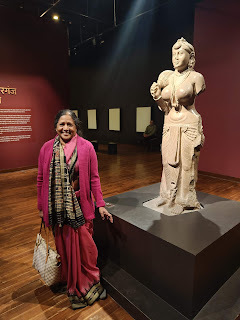


After the museum visit, we had coffee and pakoras at the museum café - It's called Potbelly and is a part of the chain that has outlets in Gurgaon and Delhi. Their chutneys are interesting - one was made of Parwal that we had not tasted before.
After the museum visit, we went for a drive on Patna's Marine Drive. This is still being developed rather along the lines of Lucknow but as a famous courtesan in the 19th Century from Kanpur once said in defence of her hometown, 'Aakhir Gomti ko Ganga bana nahin sakte!' The sheer grandeur of the Ganga at Patna has to be experienced. It is hard to see the far bank and the two bridges spanning the river on either side of the city appear almost endless. They are each around 6 Km long.
Day 2
The next day, we set off for Bodh Gaya. This is a 4 hour drive through the lush agricultural landscape of South Bihar. The boundary between South and North being the river Ganga.

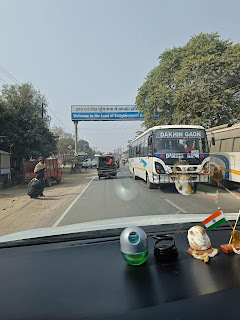
We skirted the town of Gaya set on the banks of the Falgu river and went straight to the place where Gautam Buddha had attained enlightenment. The Bodhi Temple and the Bodhi Tree under which He had meditated was clean and well kept. We had to get off on the outskirts of the town and take an electric auto (called TOTO in Bihar) to the temple. The Dalai Lama was visiting so there were more traffic restrictions than usual. The temple was full of pilgrims, mostly Tibetans settled in India but there were many from various South East Asian countries as well. There was Tibetan chanting going on and most of the pilgrims were following the text in their own books. We had a darshan of the Buddha at the Bodhi Temple but we were not allowed to take pictures. I wish the authorities would reconsider this restriction as for many of us these visits are precious and a photograph would be a great way of remembering it.
Bodh Gaya has many impressive monasteries built by Buddhist countries like Japan, Thailand and Sri Lanka. It also has a beautiful 80 ft tall statue of the Buddha.
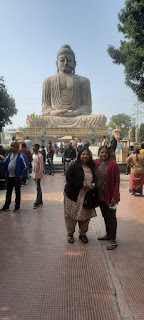
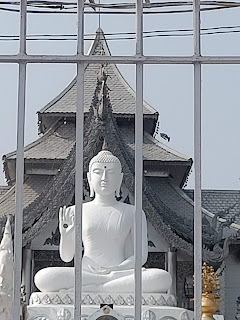
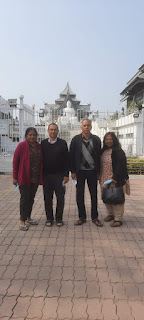
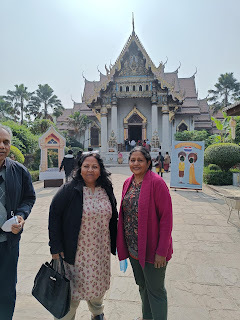
The Govt has made efforts to develop Bodh Gaya. There is a large, modern convention centre and an international airport. However given the significance of the place in the Buddhist world a lot more can be done.
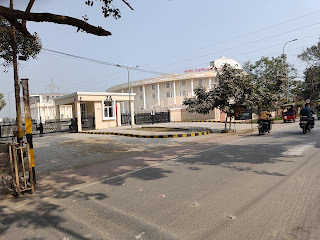
After Bodh Gaya we drove to Rajgir to spend the night. This is about 2.5 hrs. We stayed at the Kripanidhi Hotel. This has been set up by a Jain foundation so there is no alcohol (all of Bihar is dry) and strictly Jain food. That said, the food was delicious. In fact we called the chef to explain how a particular dish had been made and he told us that the gravy comprised of ground cashews and melon seeds! There is life beyond butter chicken! The rooms are elegant and so are the bathrooms. This is great choice for staying in Rajgir.
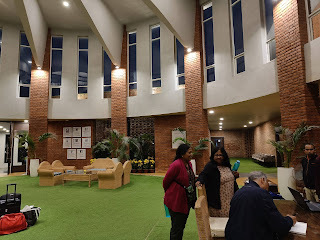
After breakfast we set off to the Vishwa Shanti Stupa in Rajgir. This is atop a hill. We took a ropeway to go up. The stupa is pristine white with gold images of Buddha on 4 sides. There's a Japanese Buddhist temple nearby where a man was beating a large drum. The place was calming and meditative. This is not an ancient stupa though but was set up fairly recently.


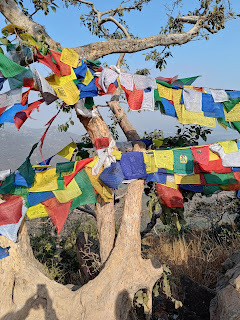
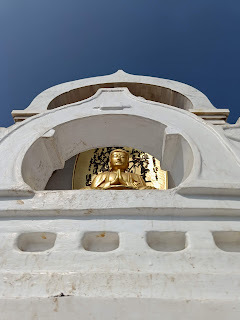
After that we went by an electric 'toto' through a forest to the oddly named Ghoda Katora. There's a calm lake in a valley with a Buddha statue in the middle. The place looked untouched and quiet. We didn't go for the safari due to shortage of time but this looked like a very exciting place for children to visit.

Our last visit in Rajgir was the museum dedicated to Huen Tsang (Xuanzang), the Chinese traveler who visited India and spent time in various parts of Bihar in the 7th Century. The museum was jointly set up in the 1950s by China and India just before the war in 1962. Huen Tsang is depicted as carrying a backpack making him one of the worlds first international backpackers. The museum is very interesting as it has various panels showing the route that he followed and the adventures on the way.


Then onwards to Nalanda. On the way we stopped at Silao to sample the famous Khaja made there. Strangely enough there is a salted version that is actually more expensive than the sweet version! Either was, it was quite delicious.
I had an impression that when the Nalanda University was burnt down by Bakhtiyar Khilji, nothing survived. On the contrary, we saw dozens of Buddha statues and artifacts that have been excavated. If one location can produce such a treasure trove, what was the whole of India like at that time? I felt the same way after seeing Khajuraho. Humbled by the glory of our civilization. There were 108 streams of learning at Nalanda encompassing medicine, astronomy, geography etc. Perhaps more than many major universities today.



Finally a visit to Pawapuri where Mahavir was cremated. The fact that two of the major religions to emerge from India, Buddhism and Jainism, essentially arose from the same place is overwhelming. What kind of society could give birth to such profound spiritual thought and that too so close together in space and time? The 'sone ki chidiya' that was India was not only rich in wealth but in knowledge as well.


From Nalanda, we drove back to Patna.
Day 3
Next morning we drove to Vaishali. Left Patna by the new bridge over the Ganga. It's a double decker bridge with the train tracks below. Very impressive structure and really long. The drive is through rich agricultural land with many small towns and villages.
Vaishali has one of the earlier Ashoka pillars. It also has a pond and various votive stupas. The pillar commemorates one of the significant events in the Buddha's life when the chief of monkeys had offered him a bowl of honey. It is also the place where the famous courtesan Amrapali was converted to a Buddhist nun. This marked the beginning of women joining Buddhism as nuns for the first time.We later saw the museum and the place where Buddha's relics were collected though only from the outside.


Returned via the Hajipur bridge. The road was crowded and the return journey took longer.Mahavir was born in Kundagram near Vaishali. All in all, as I said before this is hallowed ground for both Buddhism and Jainism and pretty much the cradle of Indian civilization and learning. .
Day 4
Mauryan remains at Kumrahar within Patna include an 80 pillared hall. Since the roof was made out of wood, nothing remains except for the pillars. Even these have been covered with earth to prevent further degradation. The remains date back to 600 BCE to the time of Ajatshatru.
There is also a dispensary that includes records of Dhanwantari, one of the three legendary physicians of ancient India. The authorities are planting a herb garden in keeping with the history of the place.

Caught a flight back to Delhi that evening. Many thanks to our hosts, Dilip and Shrimi Sinha and Uncle Dr HRP Varma for their warm hospitality and for making this amazing visit possible.

Our trip to Bihar has been an amazing immersion into the ancient history of India. One feels exhilarated and humbled by the knowledge that our forefathers had. Hopefully we will take the lead again!
Finally as a memento we brought back a beautiful statue of the Buddha - The Enlighted One in the Bhoomi Sparsh Mudra. Made of local stone in Rajgir it is greenish in colour but changes to a shining black when rubbed with mustard oil.
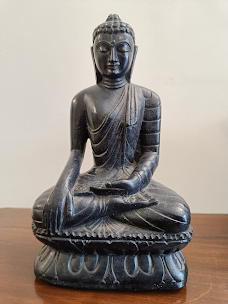
Om mani padme hum.
December 28, 2022
RIP Suman
A tribute to PM (Suman) Sinha written by my friend and colleague, Shashi Kalathil, who knew him well at Levers and Pepsi
Suman(PM) Sinha was a man’s man. His physicality permeated corporate space. As Sales Director of Hindustan Lever in the early 80’s he systematically downed barriers that differentiated ‘burra saheb’ HQ and senior management from field salesmen. Amongst several initiatives, this he manifestly did through aggressive touring, including into the hinterland, unmindful of the rigours of climate, travel and stay. If his frontline “boys” faced this day in day out, so could he every once in a while and so would the hitherto cosseted senior managers !
At Pepsi India, helmed by him for a decade where he created an organisation that decisively won the ‘cola wars’ of the 90’s, Suman took his passion for the frontline several notches up. He championed the ‘bottom up’ organisation, an inverted pyramid fronted by customer facing sales and production personnel with all other functions supporting, anchored by top management, but at the very bottom. Suman also enjoyed nothing more than a few drinks with the sales guys at the end of a hard day’s field work – so bottoms-up was just right !
Mr. Sinha however made his first mark within the corridors of ‘babudom’ as the quaintly titled Resident Manager based at New Delhi. Representing a multinational Hindustan Lever in the 70’s and 80’s and nudging policy away from the hostility of those times within a framework of ethics quite alien to the prevailing politico-business ethos must have been excruciatingly difficult, yet he pulled it off with persistent doggedness. That his next assignment was with Pepsi which was the first post liberalisation big multinational entry into India was karmic indeed !
That this nephew of Jayaprakash Narayan should have had a vaunted career in multinationals selling soaps and colas is a dichotomy that can perhaps be best resolved by Suman Sinha’s proudest moment – that Capt. Vikram Batra (PVC) should report that first of the Kargil peaks captured with the legendary Pepsi ad tagline “yeh dil maange more” !
Go well Sir, they don’t make ‘em like you no more !
Shashi Kalathil is an ex Hindustan Lever and Pepsi India veteran
February 23, 2022
Well Done India
When the history of the Covid Pandemic is written and hopefully it should be history fairly soon, there should be a special place for India. In overall terms, our country has handled this grave crisis in a mature and effective manner. There have been missteps, things that we could have done better but in overall terms we have done well. I, along with a small group of friends have been following the progress of the pandemic with keen interest and we are familiar with the numbers and statistics not only in India but abroad. I would like to highlight the following:
The first lockdown in March 2020 was draconian and sudden. It impacted the livelihoods of migrant workers in a rather harsh fashion. However, it did serve to make the Indian public aware of the grave crisis that Covid represents and what are the tools (social distancing, masking, hand hygiene etc) to combat it. Such a huge behavioural impact is very hard to achieve in a country like India especially as many of these practices are quite alien to most Indians. We are a gregarious, expressive people and the change required was almost a polar opposite. Given what we had to go through later, in hindsight, this was a painful but necessary education. We have seen that masking has generally been followed and vaccine hesitancy has hardly been there. The govt should be commended for a massive publicity blitz for constantly exhorting people in this area.Initially, we faced shortages of masks, PPE, sanitizers etc. However, this was rapidly overcome and India started exporting these items. India's reporting of the numbers and statistics has been widely criticized in Western Media. It is true that the level of testing per million was low and hence real figures of infections are much higher that what was reported. The same is true for fatalities with figures being underreported by 4 - 10 times depending on whose model you choose to believe. Having said that, to get daily information at a district level, compile it, and disseminate it without fail for the entire period of the pandemic in a complex country like ours is highly commendable. Despite the limitations, researchers were able to use the data productively and the authorities were able to come up with fairly balanced and well thought through policies. It is also worth mentioning that the Sero Positivity Surveys that were carried out frequently were also useful in planning for vaccination and epidemic control.The Delta Variant wave of April/May 2021 was truly catastrophic. Despite a focused effort to augment medical facilities in the major towns, the impact on the country was traumatic. An oxygen shortage and poor logistics contributed to the trauma. Deaths were significantly underreported and the sero positive surveys carried out later indicated the extent to which the virus had impacted the population. India, and soon afterwards the world, was just not ready for the devastating impact that Delta had. In retrospect, there was little we could have done differently. Perhaps we could have started vaccination a little earlier but in overall terms it was unlikely to have made a significant difference on the outcome. India is a poor country and decades of neglect of the healthcare sector cannot be transformed in a jiffy. Hopefully the pandemic will help to focus attention back on this critical area. Western countries who had better vaccination rates were able to stave off the worst impact of Delta but were hit by Omicron almost in parallel. However, at this point, India is better off than most of Europe and USA. It is possible that countries that were harder hit by Delta such as South Africa and India have been better protected by natural immunity than others.The process of vaccination has been a deeply satisfying achievement by India. There were a few missteps and delays in the initial stages but these were overcome. The data capture, security and user friendliness of the Cowin application has been outstanding. The scale of vaccination is also unprecedented and the supply chain from both manufacturers especially SII has been effective. India has taken its own decisions in this whole area right from the beginning. It is heartening that a local vaccine, Covaxin, has proved to be effective as well. The drive is widening now as younger people are also being covered. All in all, this has been a significant achievement by India. In retrospect, the most important lesson is that having a local supplier for critical items is the only way forward. This is equally true for pharma especially APIs. The govt has by and large exhibited a great deal of empathy for its citizens. Right from the time that Air India flew to Wuhan to evacuate Indian citizens, the Vande Bharat flights have been operating to help Indians get home. Not insisting on hospitalisation but allowing home quarantine after we gained some familiarity with the disease, free testing and vaccines etc, India has behaved in a manner befitting the world's largest democracy. There have been missteps as in the case of the migrant workers but by and large we have managed the situation as well as could be expected. Economic support packages have been measured. Economic hardship is undeniable but it is also true that the economy has bounced back and that recovery has been faster than most other countries. We are a relatively poor country and fiscal profligacy may have been a disaster in the medium term. What of the future? Opinion is divided amongst experts on what surprises Covid may yet spring on us. However, some important directions have clearly emerged:Reliance on any one country for supplies of critical items is untenable. Alternates must be found for Pharma, APIs, Semi conductors, solar panels and such like on a war footing. India is a big enough market and our costs and pricing are becoming more competitive. We must develop our own manufacturing.Healthcare needs a massive boost in terms of spending and focus. Our healthcare workers have performed wonders during the pandemic. They deserve our heartfelt admiration and gratitude. However, a lot needs to be done.It is possible that Covid may become endemic in the near future. What will that entail is still not clear. Perhaps regular booster doses and containment of local outbreaks. What it means is that we cannot afford to drop our vigilance. As of now we can say with some justification that the govt, institutions like ICMR, Vaccine manufacturers, ancillary product manufacturers, health care workers, data compilation, analysis and modelling groups, the administration and all those involved in the fight against Covid deserve our praise and thanks. Let us hope for a Covid free future.Well done India.
February 19, 2022
Friends
Most of us in the upper middle class come from small families. On my father's side, we had a total of 7 first cousins and I had only one sister. On my mother's side there were a total of 10 first cousins. I suspect that these numbers will shrink further as I see that our children's generation are happy with one or two children and sometimes not even that. The other thing is distance. Though the world has shrunk and it's so much easier to travel and communicate, Covid has shown us how this can be an illusion. Family who live in different places have found it difficult to meet in the last two years even though Whats App and Zoom have bridged the gap to some extent,
It is a platitude to say that friends are the new family. The need for emotional and social connections is a universal human condition. In the old days this need was often met by large extended joint families. Social mobility was much lower and often people spent their lives in the same town as they were born. This is becoming increasingly rare. Careers and business opportunities will dictate where you live and often you could be moving frequently between jobs and locations. This does tend to create a sort of a nomadic lifestyle where friendships are built based on where you are that time. I suppose in the broader scheme of things you need to differentiate between this almost opportunistic process and real friendship. Obviously, real friendships may also come about based on propinquity and often do. But the difference is palpable.
In my experience, real friendship is an instinctive process. It is not about a deliberate choice. Once such a chord has been struck, it will probably remain with you through your lives. Frequency of interaction and proximity are important, of course, but real friendships are not dependent on them for succor. In many ways, such friendships would represent the best that you can get in a close family relationship without the baggage that sometimes goes with them. Very often, in the latter, there could be issues of monetary misunderstandings, festering family matters and other things that preclude a more meaningful relationship. In real friendships, these have a lesser probability of happening. One because there are unlikely to be any financial transactions that could create misunderstandings and two because by their very nature, friendships are less judgmental than family relationships.
I would hasten to add that I have the very best of close family relationships and support as indeed do most of us. This is not a this vs that discussion. Rather, it is in favour of developing and maintaining those friendships and family interactions that add meaning and savour to life. Often it takes a major effort or event to break through a casual friendship and transform it into something deeply meaningful. With luck or given the right circumstances you may achieve a few such breakthroughs. Believe me a small handful of them are worth a 100 casual acquaintances.
bravo à l'amitié, the real flavour of life.
May 23, 2021
A Malthusian Twist in the Pandemic Tale
When Malthus wrote these words in the late 18th Century, he was at odds with the general view that "society was improving and in principle perfectible" - Wikipedia. The onset of the Industrial revolution fueled by monies extracted from the colonies led to a feeling of invincibility and perpetual growth during the Victorian era in Europe, which at that time was clearly the heart of the world with Britain at its core. Two world wars, several recessions, famines and earlier pandemics were not able to puncture the boundless optimism first sparked off by Vasco Da Gama in 1498 when he knocked on India's gate and laid the foundation for the Western World's wealth.
The point being made is, of course, about 'endless growth and development' and eventually thus the possibility of perfection. Related questions about science, ingenuity and whether these and other enablers have their limits too will come up when we examine these areas. It is not quite what Malthus intended to say but the import is similar. If anything, the advances in science are best exemplified by the 'warp speed' at which vaccines for Covid 19 have been developed. This should have been a good augury for the future - signifying a positive, forward looking, optimistic approach with a firm belief in science and technology at the heart of it. Almost Victorian as it were.
And yet an ominous lassitude seems to have come over us. In a curious, Malthusian twist, birth rates are plummeting around the world. The Western world and countries like Japan were facing this problem anyway but now the contagion has spread. Even countries like India are almost at replacement birth rate and the trend is accelerating rapidly. The pandemic has brought the fear of the future to our doorsteps. An uncertainty has us in its grip. You need to be optimistic about the future to procreate. Assuming that the pandemic will eventually recede, it may leave an exhausted, jaded world in its wake.
That would be the Malthusian Twist in the Pandemic Tale.
Ref: https://www.nytimes.com/2021/05/22/wo...





